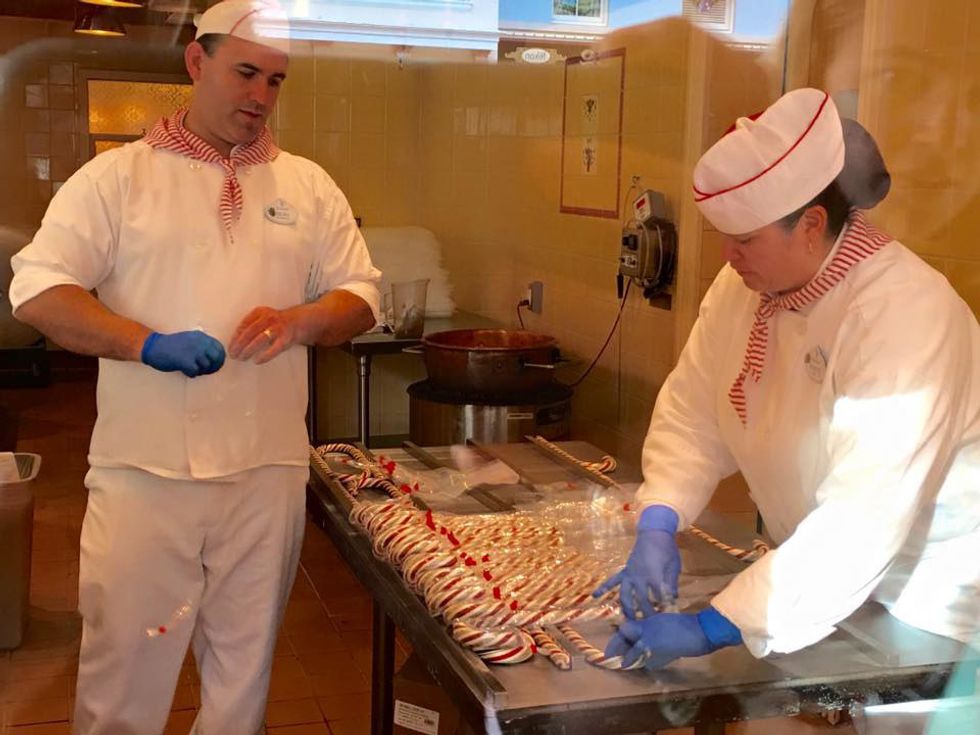When you think about holiday treats, what is the first item that comes into your mind? Fresh-out-of-the-oven desserts baked by Grandma or Mom? Gingerbread houses? Peppermint bark? Peanut brittle? Candy canes? Figgy pudding? Ok, you were probably not thinking about figgy pudding, but I guarantee that candy canes was one of the first desserts that popped into your brain. These red and white minty treats have been make a debut in our candy shops for over hundreds of years, and come in a variety of sweet and strange flavors. Some of these flavors include Swedish Fish, Hawaiian Punch, Sour Patch, birthday cake, pickle, bacon, and the most "interesting" flavor of them all, Sriracha.

Candy canes are undoubtedly the staple of Christmas, and can be found in almost every candy store, drug store, supermarkets, etc. But why are these peppermint sticks swirled in the classic red and white colors? Why is this sweet treat shaped in the iconic cane? And, most importantly, why do we associate candy canes with the holidays?
Some say that the candy cane was invented as early as the 1670s in Cologne, Germany, and spawned from the mind of an exacerbated choirmaster at the Cologne Cathedral. The reason? Unlike today's children that have access to technological entertainment such as hand held devices and portable games, children in the 17th century did not have those products to keep them occupied, especially in churches during the holidays. Therefore, children often caused disruptive behaviors, which was especially an issue for the choirmaster when he led the Living Créche sermon during Christmas Eve. To attempt to calm the children's bothersome behavior, he asked a local candy maker to create some sort of a tasty treat in the shape of a stick. He (the choirmaster) also asked the candy maker to add a small crook mark on the top of each peppermint stick to make it look like a cane. That way, the children would associate the sweet treat with the shape of the Shepard's cane, who visited the baby Jesus, hence the name, the candy cane (although some argue that the candy cane is in a shape of a J as a symbol to Jesus' name).
The red and white stripes correlated with the candy cane were also used as religious symbols to tell the story of the birth of Jesus, as well as his death. Some people have assumed over the years that the white stripes represents the purity of the Virgin Mary or Jesus during his birth. The red stripes, however, represents the lash marks on Jesus' skin when he was whipped, while the larger red marks on the candy cane represent the blood that was shed during his crucifixion. Talk about a food for thought.
Candy Canes became well-known around Germany, and soon became popular in certain European countries including England and France. Eventually, the recipe for for these red and white stripped candies was released in 1844 , and various candy shops began making their own Candy Canes to sell to the masses. It was only until the late 20th century that people began hanging candy canes on Christmas trees, and that the candy cane became associated with Christmas.
Now, you may think that the candy cane has been around in America since the invention of lightening. But "shockingly", the candy cane has only existed in the United States for less than a hundred years. Around the Roaring 20s, two candy shops, located in Chicago and Albany, Georgia began making canes canes with machines, rather than the traditional method of making the sweet treats by hand.
However, Disney Land continues making candy canes by hands, and has kept with this tradition since 1968. Guests who visit Disney Land during the holidays and make reservations to the Candy Palace not only get to try candy canes, but also learn how to make their own by scratch. I don't know about you, but that's definitely going down on my bucket list.
Whether you call them candy canes, peppermint sticks, or have some other unique nickname for them, candy canes have become a definite staple of Christmas. There's no wrong way to enjoy this delicious minty food from eating it plain, to sipping it away in your Starbucks mocha (or if you live in my house, sprinkling them on chocolate covered fortune cookies), and even eating candy cane flavored snacks. They're a refreshing way to begin the joyous holidays, and can be shared amongst your loved ones and friends. Simply, you can't go wrong with a candy cane!






















